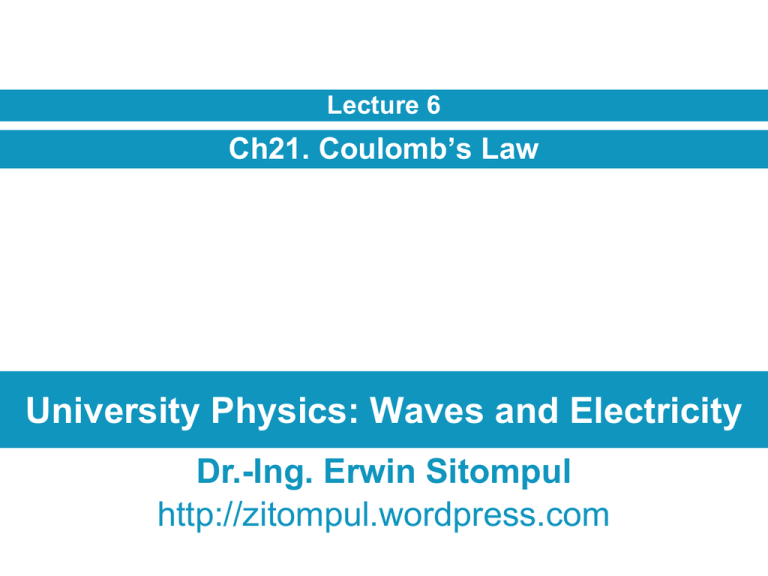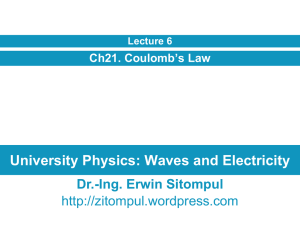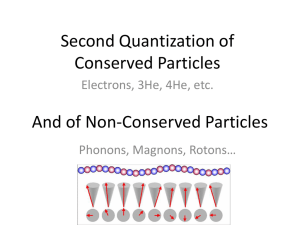+ + – q - Erwin Sitompul
advertisement

Lecture 6 Ch21. Coulomb’s Law University Physics: Waves and Electricity Dr.-Ing. Erwin Sitompul http://zitompul.wordpress.com Homework V: Ambulance Siren An ambulance with a siren emitting a whine at 1600 Hz overtakes and passes a cyclist pedaling a bike at 8 m/s. After being passed, the cyclist hears a frequency of 1590 Hz. (a) How fast is the ambulance moving? (b) What frequency did the cyclist hear before being overtaken by the ambulance? January–April 2010 University Physics: Wave and Electricity 6/2 Solution of Homework V: Ambulance Siren (a) f 1600 Hz f 1590 Hz vD 8 m s, toward S vS ?, away from D (b) f 1600 Hz f? vD 8 m s, away from S vS 10.21 m s, toward D v vD v vS 343 8 1590 1600 343 vS 1590(343 vS ) 1600(343 8) 545370 1590vS 561600 vS 10.21 m s f f v vD f f v vS 343 8 1600 343 10.21 1610.63 Hz January–April 2010 University Physics: Wave and Electricity 6/3 Electric Charge Static cling, an electrical phenomenon that accompanies dry weather, causes the pieces of paper to stick to one another.. This is an example that reveals the existence of electric charge. In fact, every object contains a vast amount of electric charge. Electric charge is an intrinsic characteristic of the fundamental particles making up those objects. The vast amount of charge in an everyday object is usually hidden because the object contains equal amounts of the two kinds of charge: positive charge and negative charge. With such a balance of charge, the object is said to be electrically neutral (contains no net charge). If the two types of charge are not in balance, we say that an object is charged, it has a net charge. January–April 2010 University Physics: Wave and Electricity 6/4 Electric Charge Charged objects interact by exerting forces on one another. Charges with the same electrical sign repel each other, while charge with opposite electrical signs attract each other. This rule will be described quantitatively as Coulomb’s law of electrostatic force between charges. (The term electrostatic is used to emphasize that the charges are stationary relative to each other.) January–April 2010 University Physics: Wave and Electricity 6/5 Coulomb’s Law If two charged particles are brought near each other, they each exert a force on the other. If the particles have the same sign of charge, they repel each other. The force on each particle is directed away from the other particle. If the particles have opposite signs of charge, they attract each other. The force on each particle is directed toward the other particle. January–April 2010 University Physics: Wave and Electricity 6/6 Coulomb’s Law This force of repulsion or attraction due to the charge properties of objects is called an electrostatic force. The equation giving the force for charged particles is called Coulomb’s law, named after Charles-Augustin de Coulomb, who did the experiments in 1785. If particle 1 has charge q1 and particle 2 has charge q2, the force on particle 1 is: F2 k q1q2 rˆ 2 12 r12 The term rˆ12 is a unit vector to the direction from position of q1 to position of q2. The term k is a constant. k 1 8.99 109 N m2 C2 4 0 0 8.854 1012 C2 (N m2 ) January–April 2010 University Physics: Wave and Electricity 6/7 Coulomb’s Law ε0 is a constant denoted as permittivity in vacuum, a measure of how the vacuum medium is affected by an electric field. As can be deducted from the constants, the SI unit of charge is the coulomb (C). y F2 k q1 + r→ 12 → r1 → r2 + q2 → F2 x January–April 2010 q1q2 r12 rˆ 2 12 r12 r2 r1 r2 r1 r12 rˆ12 r2 r1 r12 University Physics: Wave and Electricity 6/8 Some Examples on Vectors Example: If r12 4iˆ 2jˆ , find r12 and rˆ12 . r12 (4)2 (2) 2 20 4.472 r12 4iˆ 2jˆ 0.894iˆ 0.447ˆj rˆ12 4.472 r12 Example: If r1 2iˆ 3jˆ and r2 4iˆ 2jˆ , find r12 and rˆ21 . ˆ (2iˆ 3j) ˆ 2iˆ 5jˆ r12 r2 r1 (4iˆ 2j) ˆ (4iˆ 2j) ˆ 2iˆ 5jˆ r21 r1 r2 (2iˆ 3j) r12 r21 r12 r21 January–April 2010 Both vectors are of opposite direction, but have the same magnitude University Physics: Wave and Electricity 6/9 Coulomb’s Law If we have n charged particles, they interact independently in pairs, and the force on any one of them, is given by the vector sum. Let us say, we have n particles, then the force on particle 1 is given by: F1,net F12 F13 F14 F1n y + q1 q2 → F21 + q3 – → F23 → F2,net x January–April 2010 University Physics: Wave and Electricity 6/10 Example 1: Coulomb’s Law The figure below shows two positively charged particles fixed in place on an x axis. The charges are q1 = 1.610–19 C and q2 = 3.210–19 C. The q1 is located on the origin, while the separation is R = 0.02 m. What are the magnitude and direction of the electrostatic force → F12 on particle 1 from particle 2? r1 0 r2 0.02iˆ m r21 r1 r2 0.02iˆ r21 0.02 rˆ21 F12 k q1q2 r21 rˆ 2 21 (1.6 1019 )(3.2 1019 ) ˆ 8.99 10 (i) 2 (0.02) 1.151 1024 ˆi N 9 r21 ˆi r21 January–April 2010 University Physics: Wave and Electricity 6/11 Example 2: Coulomb’s Law Now, particle 3 lies on the x axis between particles 1 and 2. Particle 3 has charge q3 = –3.210–19 C and is at a distance 3/ R from particle 1. 4 → What is the net electrostatic force F1,net on particle 1 due to particles 2 and 3? r1 0 r3 0.015iˆ m r31 r1 r3 0.015iˆ r31 0.015 r ˆr31 31 ˆi r31 F13 k q1q3 r31 rˆ 2 31 19 19 (1.6 10 )( 3.2 10 ) ˆ 9 8.99 10 (i) 2 (0.015) 2.046 1024 ˆi N F1,net F12 F13 1.1511024 ˆi 2.046 1024 ˆi 8.95 1025 ˆi N January–April 2010 University Physics: Wave and Electricity 6/12 Example 3: Coulomb’s Law Particle 3 from previous example is now replaced by particle 4. Particle 4 has charge q4 = –3.210–19 C, is at a distance 3/4R from particle 1, and lies on a line that makes an angle θ = 60° with the x axis. → What is the net electrostatic force F1,net on particle 1 due to particles 2 and 4? r1 0 r4 (0.015)cos60ˆi (0.015)sin 60ˆj 0.0075iˆ 0.013jˆ r41 r1 r4 0.0075iˆ 0.013jˆ r41 (0.0075)2 (0.013) 2 0.015, equals 34 R January–April 2010 rˆ41 r41 r41 0.0075iˆ 0.013jˆ 0.015 0.5iˆ 0.867jˆ University Physics: Wave and Electricity 6/13 Example 3: Coulomb’s Law F14 k q1q4 r41 rˆ 2 41 19 19 (1.6 10 )( 3.2 10 ) ˆ 0.867ˆj) 8.99 109 ( 0.5i (0.015)2 1.023 1024 ˆi 1.774 1024 ˆj N F1,net F12 F14 1.151 1024 ˆi (1.023 1024 ˆi 1.774 1024 ˆj) (0.128 ˆi 1.774 ˆj) 1024 N January–April 2010 University Physics: Wave and Electricity 6/14 Checkpoint The figure below shows three arrangements of one electron (e) and two protons (p). (a) Rank the arrangements according to the magnitude of the net electrostatic force on the electron due to the protons, largest first a, c, b (b) In situation c, is the angle between the net force on the electron and the line labeled d less than or more than 45 °? Less than 45° p 1.602 1019 C e 1.602 1019 C January–April 2010 University Physics: Wave and Electricity 6/15 Example 4: Coulomb’s Law Two particles are fixed in place: a particle of charge q1 = +8q at the origin and a particle of charge q2 = –2q at x = L. At what point can a particle of charge q3 = +4q be placed so that it is in equilibrium (the net force on q3 is zero)? → → F32 F31 : impossible to place q3 on the left of q1 or in the middle between q1 and q2 : the only possibility is to place q3 to the right-hand side of q2 January–April 2010 → F32 → F31 → F32 → F31 University Physics: Wave and Electricity 6/16 Example 4: Coulomb’s Law F3,net F31 F32 0 q1q3 q2q3 k rˆ k rˆ 0 2 13 2 23 r13 r23 qq qq k 1 32 ˆi k 2 32 ˆi 0 r13 r23 q1 q2 0 2 2 r13 r23 8q 2q 0 2 2 ( L x) x 8 2 ( L x) 2 x 2 January–April 2010 8x2 2( L x)2 8x2 2( L2 2 xL x2 ) 6 x 2 4 L x 2 L2 0 c a b b b2 4ac x1,2 2a x1 13 L • q3 between q1 and q2 x2 L • q3 to the right of q2 Charge q3 must be placed on the x axis, at distance L to the right of q3, or, at point (2L,0) → F32 L x University Physics: Wave and Electricity → F31 6/17







